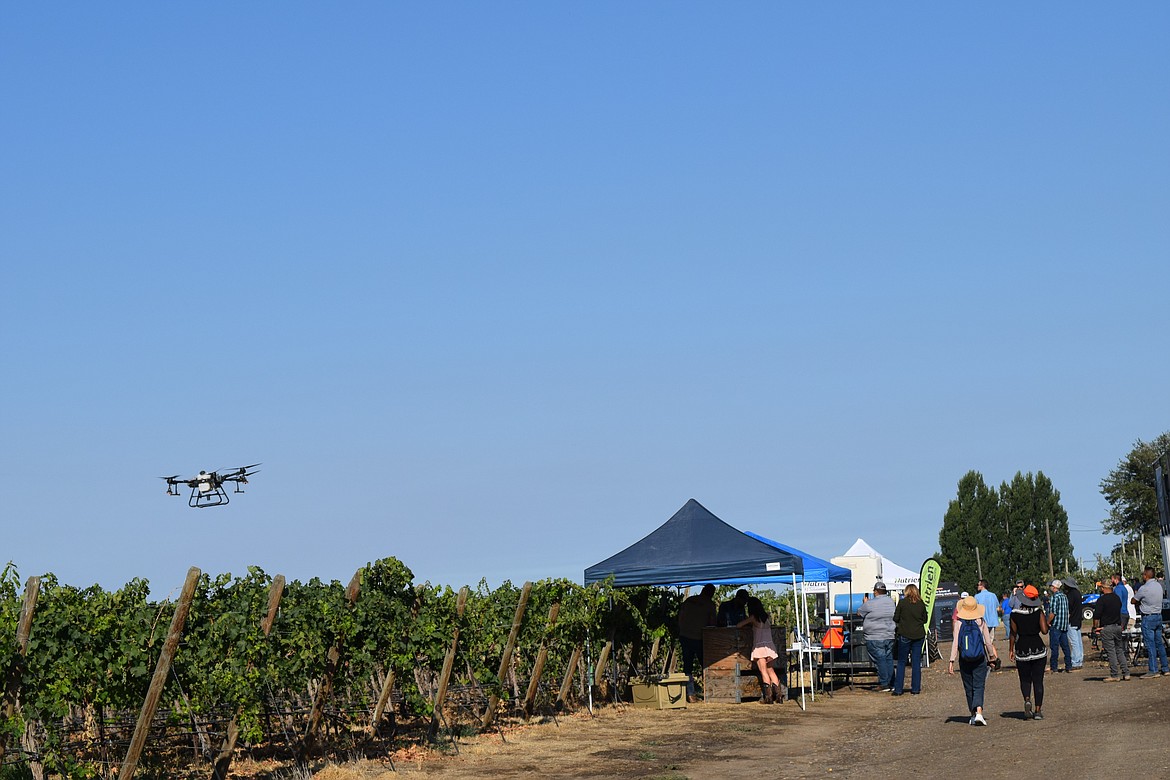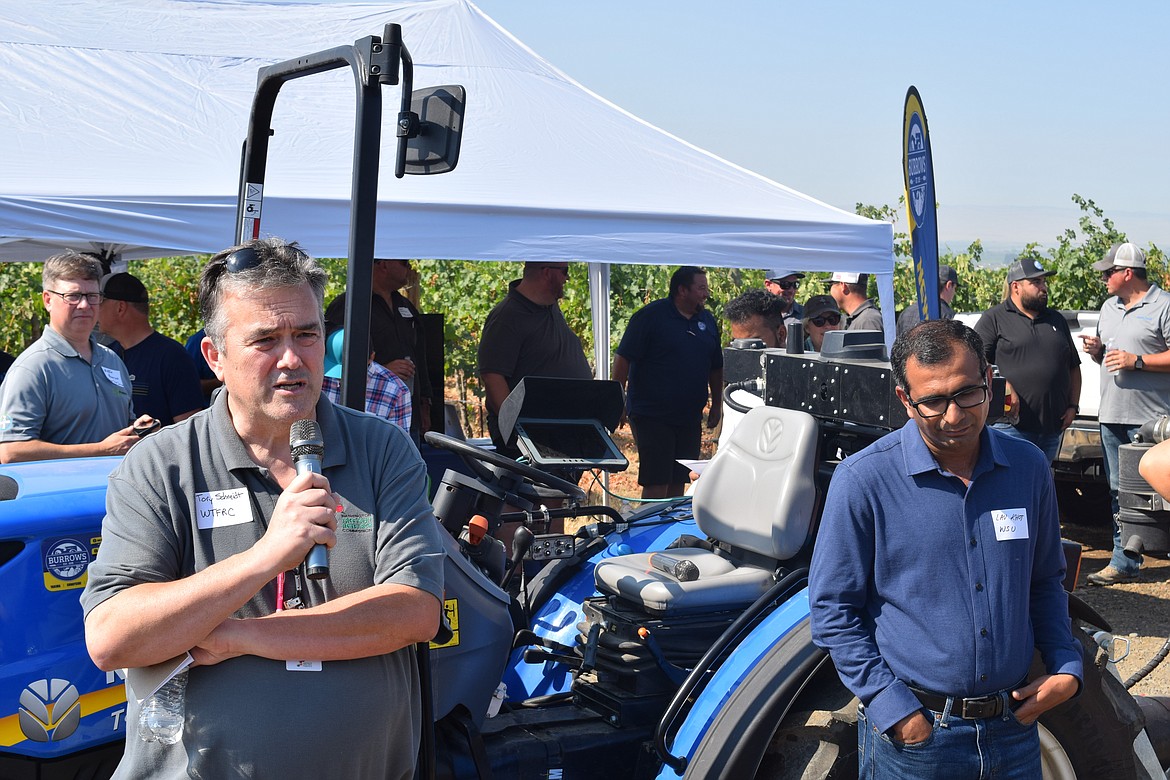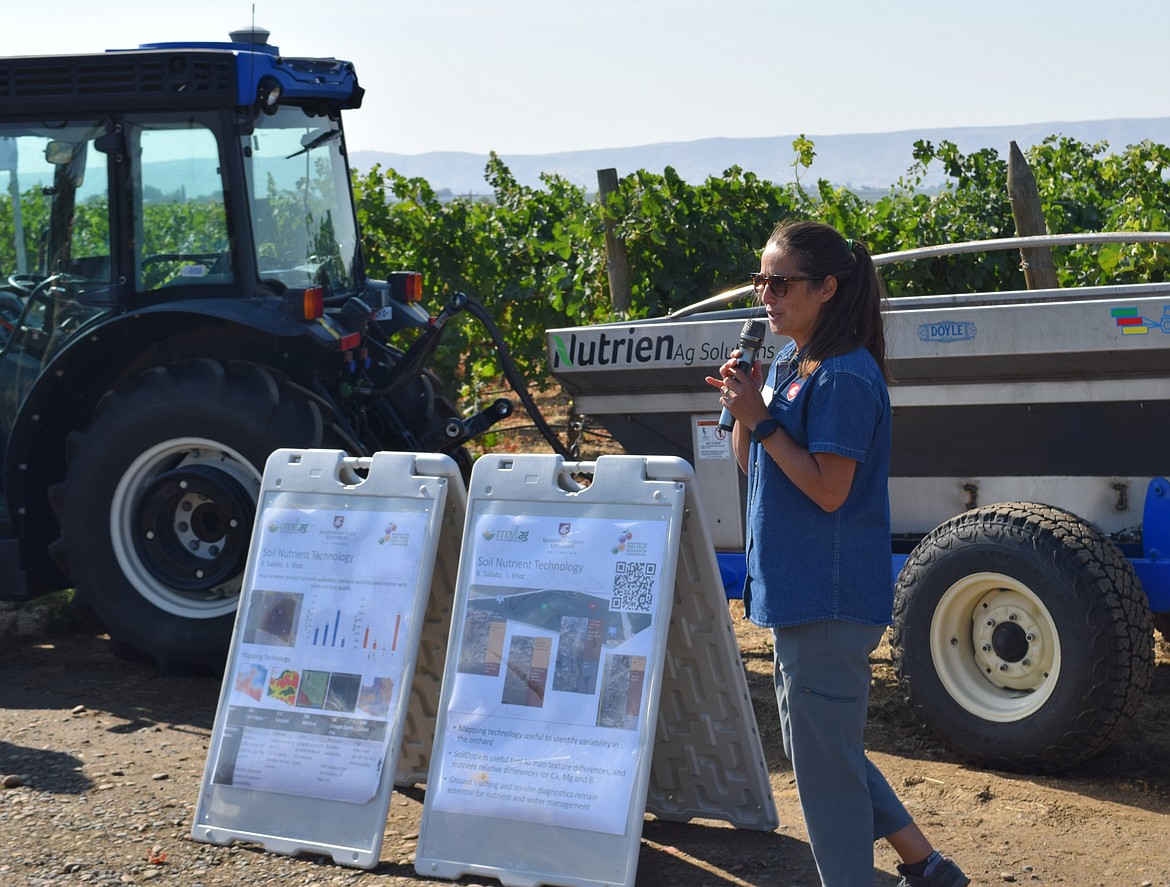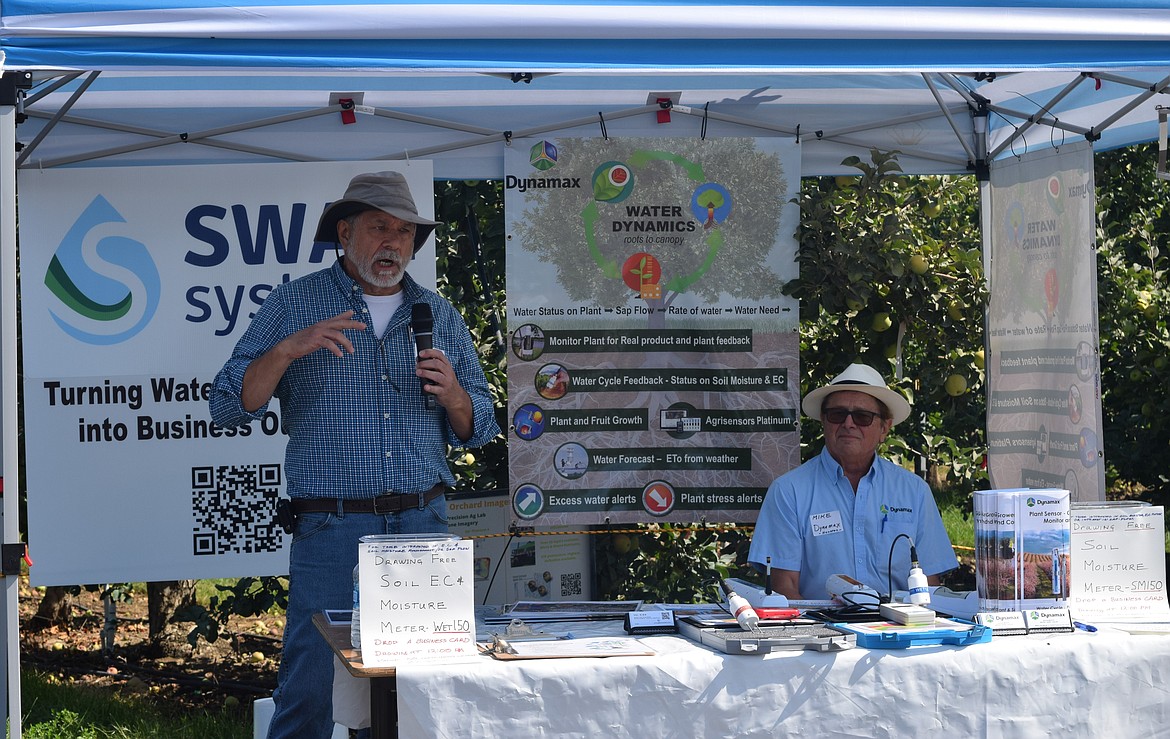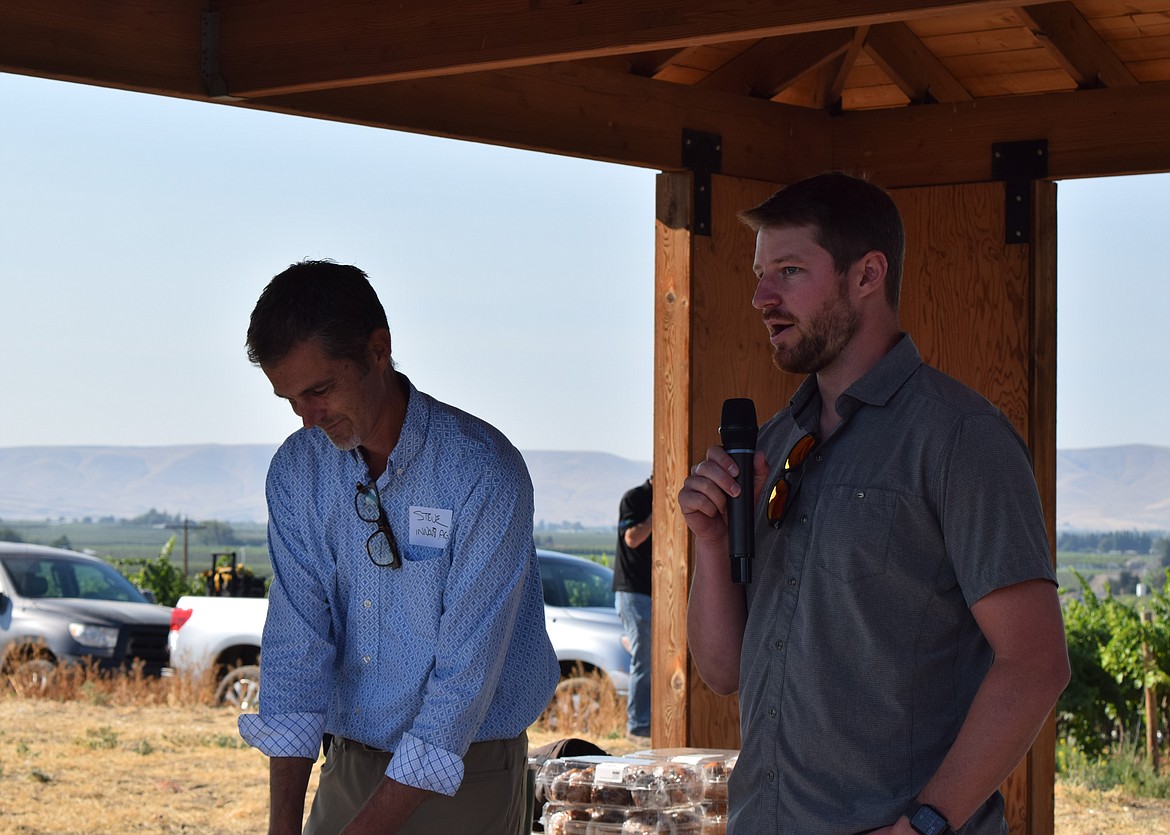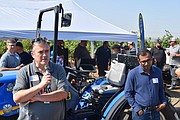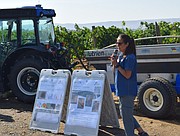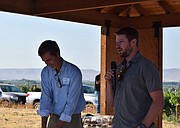Smart Orchard: Field Day showcases agricultural research from three-year project
GRANDVIEW – After three years of research on the Smart Orchard project, Innov8.ag, Washington State University Extension and the Washington Tree Fruit Research Commission hosted the 2023 Smart Orchard Field Day at Grandview Ranch on Aug. 2 to discuss their joint findings and showcase new technologies.
The Smart Orchard Field Day was the culmination of a three-year project implemented by the three organizations hosting the field day, according to an informational packet distributed at the event.
“The 2023 Smart Orchard project was a large-scale effort to use technology to improve the efficiency and sustainability of apple production,” stated the packet. “The project focused on irrigation and chemical thinning task maps, which are used to inform variable rate applications. Variable rate applications are a more efficient way to inform irrigation timing and prescription chemical use, as they allow for different rates to be applied to different areas of the orchard based on their needs.”
The Smart Orchard Field Day was located on the project’s research orchard, a Honeycrisp apple orchard block of the Grandview Ranch that is about twenty years old, said the founder of Innov8.ag, Steve Mantle.
The orchard picked for the project was intentionally highly variable and difficult to manage regarding the soil’s characteristics. The sensors and tools researched in the project usually focused specifically on improving data collection for variable orchards such as Grandview Ranch, which is owned and operated by Gilbert Plath, the head of the Washington Fruit Growers company, according to the packet.
“Ines Hanrahan of the Washington Tree Fruit Research Commission (WTFRC), Bernardita Sallato and Lav Khot of WSU Extension, and Steve Mantle, of innov8.ag all decided there was a need for an orchard where cutting-edge technology could be validated by scientists in a commercial orchard,” said the packet.
The first presentation of the field day was conducted by Sallato, a tree fruit extension specialist with the WSU Prosser Irrigated Agriculture Research and Extension Center, WSU Intern Elijah Lin and Jill Tonne, a crop consultant with Nutrien Ag Solutions. This presentation dealt with nutrients and nutrient sample collection in the orchard.
“Nutrient management is very relevant for adequate health of the trees, yield, and especially fruit quality,” said Sallato. “So traditionally the way we’ve been evaluating what we have in the soil, the availability of nutrients in the soil, has been by doing a sampling throughout the orchard, mixing those samples, getting a composite sample and sending that to the lab. So while it’s not a very complicated process, It is really hard to get an idea when we have sites like this one, and that’s why we chose this orchard”
Sallato said that to facilitate the nutrient application process and help growers have a better sense of the soil, the project researched multiple data collection tools. One that they studied extensively was SoilOptix, which is a mobile vehicle mounted sensor that maps the soil, specific on-site samples through ground truthing (measuring something you know to be true, such as a particular plant or soil sample).
“So the mapping tool does provide the ability for us to identify relative difference in your orchard, and when you have an orchard like this one where you have variability in the soil types, that tool can really help you to identify areas. Now, my recommendation is, if you want to identify those areas, you need to go and do the ground truth. So it doesn’t work on its own. You need to do the that ground truthing that you will do pretty much with every technology, right? So as a conclusion of our work…mapping technology is useful to identify variability in your orchard, not to use it as a guideline for nutrient management.”
The next presentation was on chemical spray technologies and how they affect orchard blossom characteristics. The speakers were WSU Professor Lav Khot, WSU Regional Extension Specialist Gwen Hoheisel, Tory Schmidt with the Washington Tree Fruit Research Commission and Mantle.
Schmidt spoke about spraying technology, saying that the research done in the Smart Orchard project is promising for automation and data management in the future of agriculture. He said that the new technologies can reduce the difficulties of variability in orchard growth, such as the problem of knowing which specific chemicals to spray and how much when each tree has different needs.
“I encourage you to just think about the possibilities here,” said Schmidt. “What we’re talking about here is a system, the sprayer system, that will employ not only what it sees at the time or shortly before the time that the application goes on, but can also integrate information about that individual tree or that section of the orchard from prior history.”
The final presentation of the field day was on irrigation technologies, specifically sensors and data collection devices and their role in a smart orchard.
Mike van Bavel, president of Dynamax Inc., a monitoring instrumentation manufacturer, spoke about the motivation behind the research into sensor and data collection for irrigation in orchards.
“So then we have the transpiration itself, and the idea is to give you real feedback on the plant as it’s responding to the weather. We’ll integrate the data; we’ll push that data every 15 minutes to a cloud system,” said van Bavel.
Val King, the director of business and development in North America for Swan Systems, a water and nutrient management service, spoke about what Swan’s systems bring to the table for a Smart Orchard.
“Swan gives us the ability to do system-suggested irrigation, simplified irrigation,” said King. “We take all that data together and can make an irrigation recommendation. We’re also a nutrient management platform. We can track annual water use, we can track water use efficiency…a lot of different metrics.”
The field day pamphlet provided further context for all of these presenters and organizations working together on the Smart Orchard project.
“This space served as a collaborative testing ground for new orchard and growing technologies. From dendrometers to yield mapping, and weather stations to tree-sap flow monitors, all technologies were welcome,” said the pamphlet. “Over 20 participants from academia and commercial entities participated in this 3-year project. The primary stipulation was that all data obtained in the Smart Orchard was available to all. That concept of openness is what sets this orchard apart.”


